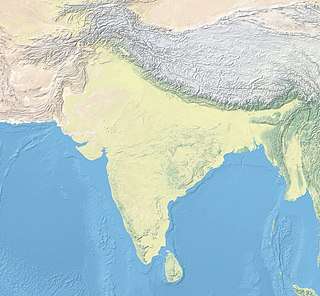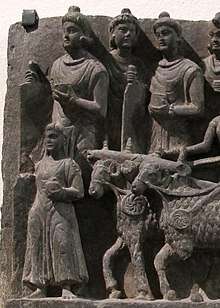University of Ancient Taxila
|
Ruins of Achaemenid city of Taxila, Bhir Mound archaeological site. | |
 Shown within South Asia | |
| Location | Taxila, modern Pakistan |
|---|---|
| Coordinates | 33°44′N 72°47′E / 33.74°N 72.78°ECoordinates: 33°44′N 72°47′E / 33.74°N 72.78°E |
| Type | Centre of learning |
| History | |
| Founded | 6th century BCE |
The University of Ancient Taxila was a renowned ancient university in the city of Taxila, then capital of the Achaemenid territories in northwestern ancient India following the Achaemenid conquest of the Indus Valley around 515 BCE. Taxila was at the crossroad of the main trade roads of Asia, was probably populated by Persians, Greeks and many ethnicities coming from the various parts of the Achaemenid Empire.[1][2] [3]
The University
The renowned University of Taxila became the greatest learning center in the region, and allowed for exchanges between people from various cultures.[4]
The University was particularly renowned for science, especially medicine, and the arts, but both religious and secular subjects were taught, and even subject such as archery or astrology.[5] Students cames from distant parts of India.[5] Many Jataka of early Buddhist literature mention students attending the University.[5]
The Achaemenid conquest of the Indus Valley made Taxila a part of the Achaemenid Empire. The Persian conquest probably made Taxila University a very cosmopolitan environment in which numerous cultures and ethnicities could exchange their knowledge.[5]
The role of Taxila University as a center of knowledge continued under the Maurya Empire and Greek rule (Indo-Greeks) in the 3rd and 2nd centuries BCE.[5]
The destructions of Toramana in the 5th century CE seem to have put an end to the activities of the University.[6]
Followers of the Buddha

Several contemporaries, and close followers, of the Buddha are said to have studied in Achaemenid Taxila: King Pasenadi of Kosala, a close friend of the Buddha, Bandhula, the commander of Pasedani's army, Aṅgulimāla, a close follower of the Buddha, and Jivaka, court doctor at Rajagriha and personal doctor of the Buddha.[7] According to Stephen Batchelor, the Buddha may have been influenced by the experiences and knowledge acquired by some of his closest followers in the foreign capital of Taxila.[8]
- Story of Angulimala as a student in Taxila
A Buddhist story about Aṅgulimāla (also called Ahiṃsaka, and later a close follower of Buddha), relates how his parents send him to Taxila to study under a well-known teacher. There he excels in his studies and becomes the teacher's favorite student, enjoying special privileges in his teacher's house. However, the other students grow jealous of Ahiṃsaka's speedy progress and seek to turn his master against him.[9] To that end, they make it seem as though Ahiṃsaka has seduced the master's wife.[10]
Other famous students or professors
Charaka
Charaka, the Indian "father of medecine" and one of the leading authorities in Ayurveda, is also said to have studied at Taxila, and practiced there.[11][12]
Pāṇini
The great 5th century BCE grammarian Pāṇini is said to have been born in the northwest, in Shalatula near Attock, not far from Taxila, in what was then a satrapy of the Achaemenid Empire following the Achaemenid conquest of the Indus Valley, which technically made him in all probability a Persian subject.[13][14][15]
Kautilya
Kautilya (also called Chanakya), the influential Prime Minister of the founder of the Mauryan Empire, Chandragupta Maurya, is also said to have been a professor teaching in Taxila.[16]
Chandragupta Maurya
Buddhist literature states that Chandragupta Maurya, though born near Patna (Bihar) in Magadha, was taken by Chanakya for his training and education to Taxila. There he studied for eight years.[17] The Greek and Hindu texts state that Kautilya (Chanakya) was a native of the northwest Indian subcontinent, and Chandragupta was his resident student for eight years.[18][19]
See also
References
- ↑ Lowe, Roy; Yasuhara, Yoshihito (2016). The Origins of Higher Learning: Knowledge networks and the early development of universities. Routledge. p. 62. ISBN 9781317543268.
- ↑ Le, Huu Phuoc (2010). Buddhist Architecture. Grafikol. p. 50. ISBN 9780984404308.
- ↑ Batchelor, Stephen (2010). Confession of a Buddhist Atheist. Random House Publishing Group. p. 255-256. ISBN 9781588369840.
- ↑ Batchelor, Stephen (2010). Confession of a Buddhist Atheist. Random House Publishing Group. p. 125. ISBN 9781588369840.
- 1 2 3 4 5 Marshall, John (2013). A Guide to Taxila. Cambridge University Press. pp. 23–24. ISBN 9781107615441.
- ↑ The Pearson CSAT Manual 2011. Pearson Education India. p. 439/ HC.23. ISBN 9788131758304.
- ↑ Batchelor, Stephen (2010). Confession of a Buddhist Atheist. Random House Publishing Group. p. 256. ISBN 9781588369840.
- ↑ Batchelor, Stephen (2010). Confession of a Buddhist Atheist. Random House Publishing Group. p. 255. ISBN 9781588369840.
- ↑ Malalasekera 1960.
- ↑ Wilson 2016, p. 286.
- ↑ Lowe, Roy; Yasuhara, Yoshihito (2016). The Origins of Higher Learning: Knowledge networks and the early development of universities. Routledge. p. PT62. ISBN 9781317543268.
- ↑ Gupta, Subhadra Sen (2009). Ashoka. Penguin UK. p. PT27. ISBN 9788184758078.
- ↑ Scharfe, Hartmut (1977). Grammatical Literature. Otto Harrassowitz Verlag. p. 89. ISBN 9783447017060.
- ↑ Bakshi, S. R. (2005). Early Aryans to Swaraj. Sarup & Sons. p. 47. ISBN 9788176255370.
- ↑ Ninan, M. M. (2008). The Development of Hinduism. Madathil Mammen Ninan. p. 97. ISBN 9781438228204.
- ↑ Schlichtmann, Klaus (2016). A Peace History of India: From Ashoka Maurya to Mahatma Gandhi. Vij Books India Pvt Ltd. p. 29. ISBN 9789385563522.
- ↑ Mookerji 1988, pp. 15-18.
- ↑ Mookerji 1988, pp. 18-23, 53-54, 140-141.
- ↑ Modelski, George (1964). "Kautilya: Foreign Policy and International System in the Ancient Hindu World". American Political Science Review. Cambridge University Press (CUP). 58 (03): 549–560. doi:10.2307/1953131.
Sources
- Malalasekera, G.P. (1960), Dictionary of Pāli Proper Names, 1, Delhi: Pali Text Society, OCLC 793535195
- Wilson, Liz (2016), "Murderer, Saint and Midwife", in Holdrege, Barbara A.; Pechilis, Karen, Refiguring the Body: Embodiment in South Asian Religions, SUNY Press, pp. 285–300, ISBN 978-1-4384-6315-5
- Mookerji, Radha Kumud (1988) [first published in 1966], Chandragupta Maurya and his times (4th ed.), Motilal Banarsidass, ISBN 81-208-0433-3